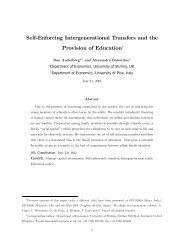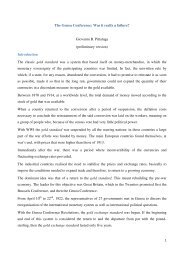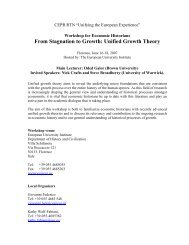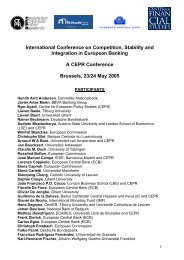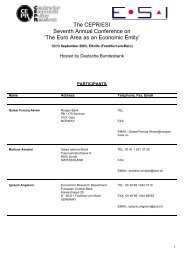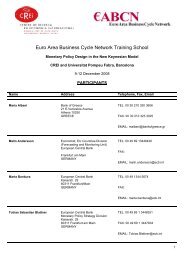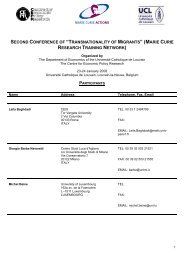MARKET STRUCTURE AND ENTRY: WHERE'S THE BEEF? - CEPR
MARKET STRUCTURE AND ENTRY: WHERE'S THE BEEF? - CEPR
MARKET STRUCTURE AND ENTRY: WHERE'S THE BEEF? - CEPR
Create successful ePaper yourself
Turn your PDF publications into a flip-book with our unique Google optimized e-Paper software.
11 Note that if market-specific unobserved heterogeneity were important, we would expect on average that<br />
the proportion of entries by each player would not differ significantly across existing market structures.<br />
The fact that these proportions are substantially different implies something more than that is going on in<br />
the data.<br />
12 Analysis of the data reveals that of 2,260 observations, BK has multiple entry only 15 times (12 times<br />
with 2, 3 times with 3 outlets) whereas the corresponding number for McD is 13 (all with 2 outlets).<br />
13 We used end of period market structures in order to include entry from our last observation period.<br />
14 We note that a large population is not necessary condition for entry. London’s City of Westminster,<br />
with a population of less than 6 000, has the largest number of outlets for both firms. It is however<br />
excluded from the estimation sample together with two other London districts (City of London, and<br />
Kensington and Chelsea). The reason for this is that for all three districts, the daytime population is<br />
significantly higher than the resident population.<br />
15 See Toivanen and Waterson (2000) for one solution to this problem.<br />
16 We employ the standard quadrature method (with 20 evaluation points) suggested by Butler and Moffit<br />
(1982) to estimate the random effects probit.<br />
17 We should point out that the vectors of market structure dummies employed for the two firms are<br />
different, because in a discrete choice model one cannot use as a regressor a dummy variable if for any of<br />
the values it takes, there is no variation in the dependent variable (see e.g. Greene, 1995, pp. 416). Thus,<br />
for example, we excluded the dummies M0B2 and M1B2 from the BK estimation as there was no BK entry<br />
into such markets during our observation period.<br />
18 The quarters are ranked ascendingly in the number of outlets opened for each year, and – for what it is<br />
worth given the small sample – the differences in the mean number of outlets opened in a quarter are<br />
significant at the 4% (or higher) level. These patterns are, if anything, stronger within our sample period.<br />
19 For markets without existing own outlets, the entry rule takes the following form within our<br />
specification:<br />
S(.)[γi1AREA jt+γi2WAGEjt+θiV1+θiV2RIVALjt+θiV3RIVALjt<br />
+θiV4OWNNBjt +θiV5RIVALNBjt]-(δi0+dit’t+εijt)>0.<br />
It allows us to identify all parameters in S(.), all the market characteristic parameters in V(.) (the γij’s), the<br />
neighborhood parameters, and the own outlet coefficient in V(.). Also, we can identify the entry cost<br />
parameters F(.). We cannot separately identify the rival and rival-own-outlet variables’ coefficients (θiV2<br />
and θiV3).<br />
The entry decision rule in markets with existing own outlets takes the following form:<br />
S(.)(θiV1+θiV3RIVALjt)-(δi0+dit’t+εijt)>0. Thus, it allows us to identify all coefficients in S(.) and F(.), and<br />
θiV1 and θiV3 in V(.), i.e., the own outlet and the own-rival outlet variables’ coefficients. As we estimate the<br />
entry decisions into these two types of markets jointly, we can identify the linear rival outlet coefficient in<br />
V(.) by combining the information in the above equations. Our assumption that zero own outlets yields zero<br />
profits is behind this identification result.<br />
45



